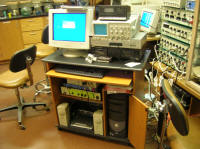BIO340 Laboratory Guide #7
CONTROL OF MICROVASCULAR CIRCULATION IN
THE FROG TONGUE

The circulatory system of vertebrates is ultimately designed to service the metabolic needs of the tissues. Specifically the circulatory system functions as an intermediate transport system between the tissue and the external environment. Systemic capillary blood flow and its control are of particular importance, because this is the site of exchange of gases, nutrients, and metabolic wastes between the blood and tissues.
Capillary blood flow is regulated by adjusting the degree of contraction in the smooth muscle surrounding small arteries, arterioles, venules, and especially the precapillary sphincters at the junctions between terminal arterioles and capillary beds. Poiseuille's Law is a mathematical formulation which describes laminar (non-turbulent) fluid flow through such tubes:
Q = [(PA-PB)pr4]/8Lh
where (PA-PB) is the pressure drop from one end of the tube to the other, r is the radius of the tube, L is the length of the tube, h is the viscosity of the fluid, and Q is the resultant rate of flow of the fluid. According to this law, doubling the radius (r) of a vessel will increase the rate of fluid flow (Q) through that tube by a factor of 16. Alternatively, even a small decrease in vessel radius will greatly diminish flow rate. Complete contraction of precapillary sphincters may completely block blood flow to a capillary bed.
The arteries and larger arterioles are primarily regulated by neural activity, while the smaller, terminal arterioles respond primarily to local influences, such as oxygen levels, pH, and concentrations of metabolic intermediates. Smooth muscle contraction in venules and veins does little to control local capillary flow directly, but controls overall systemic functional blood volume by adjusting the volume of the venous "reservoir".
We will test solutions of several chemical compounds which function as local mediators to increase or decrease blood flow in the microcirculation. We will also look at the effects of some pharmacological antagonists to these local mediators. The tongue of a freshly pithed frog will serve as our model system for these studies.
Additional Reading:
Pages 495-499, 506-510 in Eckert Animal Physiology (5th Ed.) by Randall, Burggren, and French.
I. SETUP
This lab works best if no more than 2 students share a microscope and frog. Some of the responses occur very rapidly, then just as rapidly reverse. You have to be literally looking at the tongue under the microscope as you add the substance, or you will miss the effect(s). If possible take turns at the microscope and repeat applications, so that each person can see each response.
The equipment needed for this lab includes a dissecting microscope, a timer, a gooseneck lamp, a frog board, about a dozen small dissecting pins, some frog Ringer's solution, several plastic pipets (large for rising the tongue and small for chemical applications), and a set of chemical test solutions.
Setup Procedure:
1) Cover the frog board with plastic wrap, then clear the plastic wrap from the area of the observation hole.
2) Obtain a freshly pithed frog from your instructor. Wrap the frog's body with a 2-3 wet paper towels. Place the frog dorsal side up on the frog board, with the point of the jaw even with the near edge of the observation hole, and secure it in place with a few rubber bands.
3) Open the frog's mouth, grasp the tongue with a pair of forceps, and extend it out across the observation hole. The tongue is attached at the front of the mouth, so grasp the rear portion of the tongue to pull it out.
4) Stretch the tongue out fully over the hole and pin it in place around the periphery. Try to keep your pins as close to the edge of the tongue as possible, and try to avoid piercing any major blood vessels.
5) Center the frog's tongue on the microscope stage, then secure the board in place with several large pieces of modeling clay.
6) Turn on the lamp and position it over the frog's body. The lamp will keep the frog warm and improve circulation, but will tend to dry out the frog. Periodically moisten the paper towels surrounding the frog with water.
7) Keep the frog's tongue moist on both sides at all times using Ringer's solution, NOT plain water.
II. OBSERVATIONS
Local mediators of vasoconstricition and vasodilation usually have a fairly rapid effect and short time course of action. Why is this important for their function?
Examine the tongue under the microscope. Start at low power, then change objectives as necessary. If there are problems focusing, make sure that your objective lens is clean. You may also have to adjust the amount of light for best viewing. Locate an area of the tongue which is thin - generally towards the edge of the tongue rather than near the center. Select a spot that has several small vessels, preferably at least one of which bifurcates or is an anastomosis between two vessels. Once you locate an appropriate area, try not to move the frog.
A. Promoting Peripheral Circulation
The initial circulation may be relatively slow for several reasons. Cool temperatures, the neural shock of pithing, and physical manipulation of the tongue can all cause vasoconstriction. Warming the frog, bathing the tongue with warm Ringer's solution, quietly cursing your luck, or simply waiting a few minutes may speed the circulation. If you have tried all of these and your frog still shows no circulation, then start over with another frog.
B. Observations of Microvascular Flow
Look for red blood cells moving through the vessels. Frog red blood cells are elongated and retain their nuclei, unlike the disc-shaped mammalian RBCs. Move the board slightly, as necessary to observe flow in both arterioles and venules. These can be differentiated by observing flow past branch points. Observe the laminar flow pattern of individual RBCs in a larger arteriole or venule.
Q1: Are the RBCs in the center of the vessel moving faster or slower than those near the edge of the vessel? Why?
In the smallest capillaries, blood cells will flow single file. Find and observe such a capillary. Look for capillaries which are in the act of closing or opening.
Q2: Should you expect all of the capillaries in your field of view to be wide open at any one time? Why or why not?
Q3: Is there any feasible way of determining how many capillaries there are in your field of view, or will some always be closed, and hence, invisible?
C. Effect of Local Mediators on Microcirculation
Apply each of the following solutions directly to the area of the tongue in your microscope field. Use one of the 1 ml (smaller size) plastic pipets and apply a single drop of solution to the area. Make sure that your partner is looking through the microscope as you apply the solution.
If you observe an immediate effect, record the effect, then rinse the tongue off with a generous amount of Ringer's solution. Use one of the larger pipets for this. As indicated above, if there was a clear effect, you may want to switch people on the microscope and repeat the application, so that everyone gets a chance to see and agree on the effect. If you have not observed an effect within five minutes, rinse the tongue with Ringer's and proceed to the next solution.
1) Lactic acid Lactic acid is acidic and an indicator of high metabolic demands and/or inadequate circulation, leading to anaerobic metabolism. Lactic acid should, therefore have the effect of increasing local circulation.
2) Norepinephrine (NE) Norepinephrine is the postganglionic transmitter in the sympathetic nervous system. It acts on smooth muscle cells of the arterioles and precapillary sphincters via a-adrenergic receptors, and is a mild vasoconstrictor.
3) Serotonin (5HT) In addition to being a CNS neurotransmitter, 5HT is also an immune mediator, which is released in response to the same factors which trigger histamine release, e.g. in inflammatory responses. Serotonin also binds to platelets and facilitates their aggregation.
4) Epinephrine (E) The epinephrine response is very fast and can only be observed at virtually the instant the chemical is applied. If the effect is too rapid to see, rinse the area repeatedly with Ringer's for 10 minutes, then reapply a 10-fold dilution of the epinephrine solution. While we associate epinephrine with its central effects of increasing heart rate, in the periphery epinephrine is a potent vasoconstrictor, whose effects are mediated by a-adrenergic receptors. Epinephrine thus functions to increase vascular peripheral resistance, elevate arterial blood pressure, and shunt blood back into the central circulation. Following your application of epinephrine, rinse the area several times with Ringer's over a 10-minute period, to restore the original level of circulation.
5) Acetylcholine (ACh) Acetylcholine interacts with muscarinic cholinergic receptors of the endothelium lining the precapillary arterioles. It triggers the production and release of nitric oxide (NO) which, in turn, diffuses to the smooth muscle of the sphincters and causes it to relax. ACh, therefore, acts indirectly as a vasodilator. The difficulty with seeing this effect is that most tissues, including blood, have high levels of the enzyme acetylcholinesterase, which rapidly hydrolizes and inactivates acetylcholine. The vasodilatory effect of applied ACh is therefore very transient. If you don't see an effect after 2-3 applications, simply document what you did see, and continue to the next solution.
6) Atropine Atropine blocks muscarinic receptors, and should therefore block the ACh effect. If you did not see a good ACh effect, then proceed directly to the next solution. If you did see an ACh effect, then try blocking it with a prior application of atropine.
7) Caffeine Apply a drop of caffeine and observe any direct effects on microcirculation.
8) Adenosine In the central nervous system high adenosine levels are associated with sleepiness. Caffeine blocks adenosine receptors, which is why caffeine is a central stimulant. Apply a drop of adenosine to your frog tongue, observe any effects over the next minute or so, then apply a drop of caffeine.
9) Histamine (H), Cimetidine (Tagamet), and Diphenhydramine (Benadryl) Histamine is a potent local vasodilator and vasopermeator, released from mast cells and basophilic white blood cells as part of the inflammatory response. Diphenhydramine blocks the H1 receptors which mediate this response. Cimetidine blocks H2 receptors, which are not involved. Apply a drop of histamine solution, and observe for about 1 minute, or until a clear dilatory effect has taken place. Apply a drop of cimetidine. There should be little effect. Now apply a drop of diphenhydramine solution. The effect should be immediate and dramatic.
Q4: Do all of your observed chemical/drug effects agree with what you might have predicted, given the known effects? Can you account for any deviations of your results from your predictions?
D. Finishing Up
If you have time, and if your frog tongue is still viable, you may repeat any of the chemical applications which produced unexpected results. When you are through with the experiment, detach and dispose of the frog, and clean off the frog board, microscope, and table. THOROUGHLY WASH YOUR HANDS AFTER YOU HAVE FINISHED CLEANING UP.
III. PREPARATION OF THE LAB DATA SHEET
There is no data sheet for this laboratory, but questions from this lab may appear on the lab final. After we finish the review, you should go home. Really.
